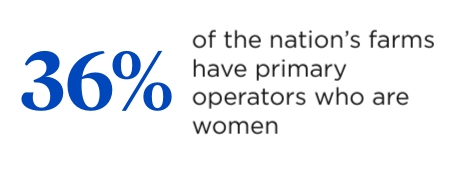The diversity of today’s agriculture customers
A diverse agricultural workforce fosters innovation by introducing new perspectives. This ranges from managing and operating farms and ranches to filling leadership roles in agribusinesses. People who have been historically underrepresented in agriculture offer new and different perspectives that can help to ensure agriculture evolves to meet the world’s growing needs for food, feed, fuel and fiber well into the future.
 Rural America is also diversifying. Despite an overall population decline in rural areas between 2010 and 2020, that decade saw an increase of racial or ethnic minorities in rural areas, according to 2020 U.S. Census data.1 Today, women, Hispanic/Latino and Black farmers, ranchers and agribusiness leaders as well as foreign farm workers all play growing roles in the increasingly diverse industry, including as farm owners and managers. Learn more about each of these segments of the population below.
Rural America is also diversifying. Despite an overall population decline in rural areas between 2010 and 2020, that decade saw an increase of racial or ethnic minorities in rural areas, according to 2020 U.S. Census data.1 Today, women, Hispanic/Latino and Black farmers, ranchers and agribusiness leaders as well as foreign farm workers all play growing roles in the increasingly diverse industry, including as farm owners and managers. Learn more about each of these segments of the population below.
Women farmers
Women lead thousands of farms and agribusinesses in the U.S. The latest U.S. Department of Agriculture (USDA) Census of Agriculture showed women are the primary operators of 36% of the nation’s farms.2

That number has grown over the years, and the trend is expected to continue with the rise in the number of farms transferred to the next generation in coming years. The Census of Agriculture also showed 56% of U.S. farms had a “female producer.” Female-operated farms “accounted for 38% of U.S. agriculture sales and 43% of U.S. farmland.”
Hispanic/Latino farmers
The Hispanic/Latino community has also long been a major contributor to American agriculture. In 2017, the Census of Agriculture showed around 83,000 Hispanic/Latino principal farm operators in the U.S.

This accounts for only around three percent of all farm operators in the United States and includes individuals with various ethnic backgrounds who identify as Hispanic/Latino. But the number of Hispanic/Latino farm leaders is growing exponentially. The number grew by 124% between 2007 and 2017.3
Black farmers
Black farmers have historically faced significant challenges like systemic discrimination, resource constraints and land losses. However, the efforts of various organizations and individuals have sought to address these issues and promote the growth of farms owned by people of color.
 According to the 2017 USDA Census of Agriculture, there were approximately 49,000 Black farm operators in the U.S. They accounted for about 1.6% of all U.S. farms. Black farmers account for $846 million in ag sales, the latest 2017 Census of Agriculture data shows.4 Almost half of all Black-owned farms are in the beef or dairy sectors, according to a McKinsey & Company report.5
According to the 2017 USDA Census of Agriculture, there were approximately 49,000 Black farm operators in the U.S. They accounted for about 1.6% of all U.S. farms. Black farmers account for $846 million in ag sales, the latest 2017 Census of Agriculture data shows.4 Almost half of all Black-owned farms are in the beef or dairy sectors, according to a McKinsey & Company report.5
The vital role of foreign farm workers
Labor has been a challenge for farmers, ranchers and agribusiness managers around the country in recent years. Overcoming that challenge with the hugely important foreign farm worker population requires awareness of the process for introducing them into a farm business and securing the required visas and other legal requirements.
Often, this includes training, health care and language assistance. Nationwide sponsors Proteus, who provides these essential services and can help your customers integrate foreign workers into their operations. The company also provides farm employers with human resource assistance in enabling foreign farm workers to get key services, even when there’s a language barrier. It enables employers to devote more attention and resources to ensuring smooth, successful farm operation.
Nationwide and diversity in agriculture
Nationwide is committed to being a part of laying the groundwork for growing diversity in agriculture. Sponsored organizations like Minorities in Agriculture, Natural Resources and Related Sciences (MANRRS) provide leadership and resources for historically underrepresented populations in agriculture. And FarmHer empowers women to become even more involved in agriculture.

